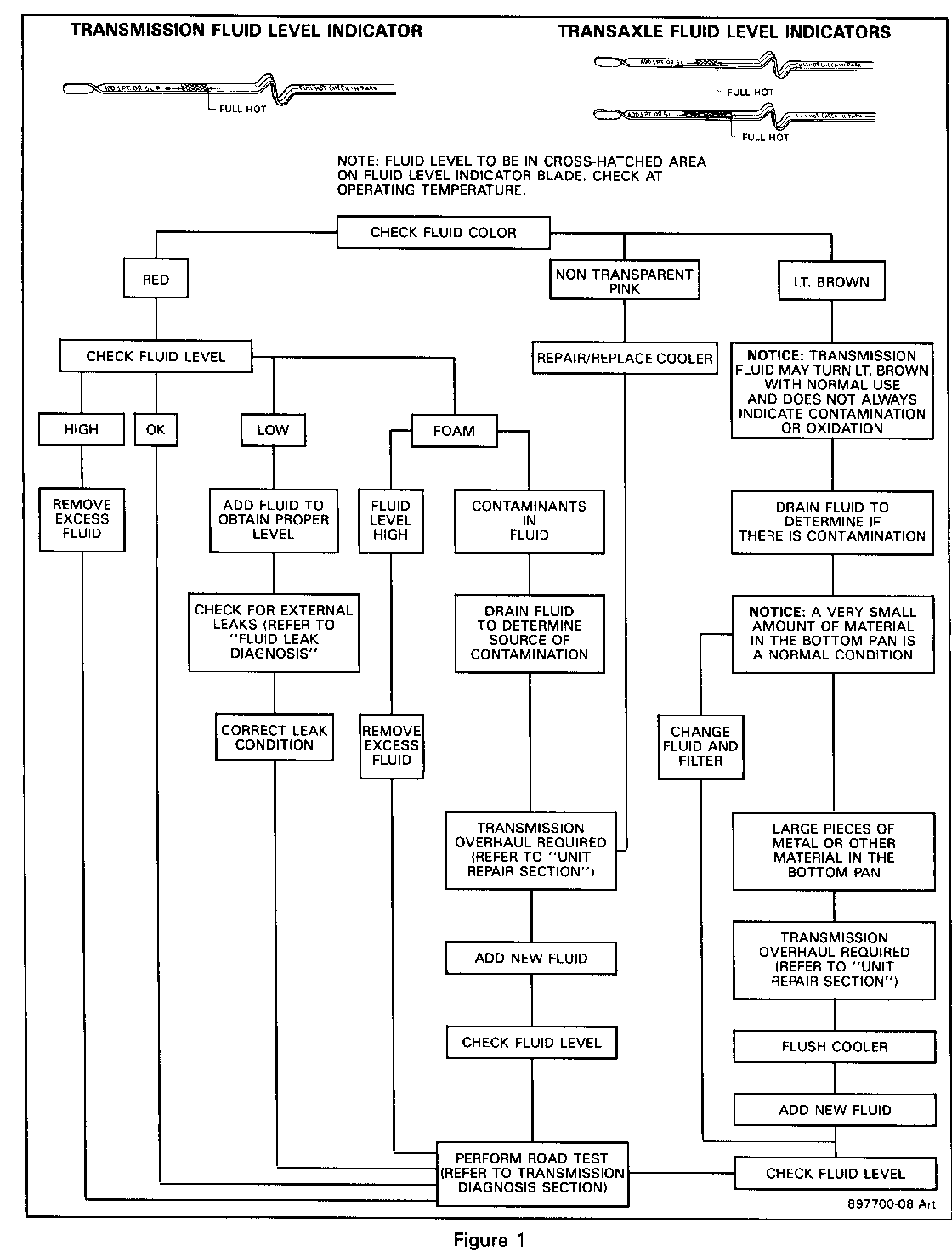A/T TRANSAXLE FLUID COLOR LEVEL CHECK INFORMATION

MODELS: ALL 1987-89 S/T, C/K, R/V TRUCKS AND M, G, P VANS EQUIPPED WITH HYDRA-MATIC AUTOMATIC TRANSMISSIONS
BULLETIN COVERS:
Service Manual update for Transmission fluid level and condition information. This information is updated for 1989 service manuals printed prior to June 1989.
TRANSMISSION FLUID LEVEL INFORMATION:
Checking fluid level and condition (color and odor) at regular intervals will provide early diagnosis information about the transmission. This in- formation may then be used to correct a condition that, if not detected early, could result in major transmission repairs.
When adding or changing fluid, use only DEXRON II. Refer to Maintenance and Lubrication (Service Manual Section OB) for maintenance information and servicing intervals.
NOTICE: Do not overfill. Overfilling will cause foaming, loss of fluid, shift complaints and possible damage to the transmission.
Fluid level should only be checked when it reaches a normal operating temperature of 82-93C (180-200F). This temperature is reached after approximately 24 km (15 miles) of driving.
TRANSMISSION FLUID COLOR:
- Fluid color will be red when new.
IMPORTANT: When new, automatic transmission fluid is red in color. The red dye is added so the assembly plant can identify it as transmission fluid and distinguish it from engine oil or anti-freeze. The red dye is not an indicator of fluid quality and is not permanent. As the vehicle is driven, the transmission fluid will begin to look darker in color. The color may eventually appear light brown. A dark brown color along with a burnt odor may indicate excessive fluid deterioration and signal a need for fluid change.
TRANSMISSION FLUID CHECKING PROCEDURE:
1. Start engine and drive vehicle for a minimum of 24 km (15 miles), or until normal operating temperature is reached.
NOTICE: The automatic transmission fluid level must be checked with the vehicle at normal operating temperature, 82-93C (180-200F). Temperature will greatly affect transmission fluid level. If the vehicle is not at normal operating temperature and the proper checking procedures are not followed, the result could be a false reading of the fluid level indicator and an incorrect adjustment of the fluid level.
2. Park vehicle on level ground.
3. Move gear selector to "PARK".
4. Apply parking brake and block wheels.
5. Let vehicle idle for 3 minutes with accessories off.
6. Check fluid level, color and condition (refer to Figure 1).
Inaccurate fluid level readings will result if the fluid is checked immediately after the vehicle has been operated under certain conditions:
- In high ambient temperature above 32C (90F). - At sustained high speeds. - In heavy city traffic during hot weather. - As a towing vehicle. - In commercial service (taxi or pohce use).
* If the vehicle has been operated under these conditions, shut the engine off and allow the vehicle to "cool" for thirty (30) minutes. After the cooldown period, restart the vehicle and continue from step "2" above.

General Motors bulletins are intended for use by professional technicians, not a "do-it-yourselfer". They are written to inform those technicians of conditions that may occur on some vehicles, or to provide information that could assist in the proper service of a vehicle. Properly trained technicians have the equipment, tools, safety instructions and know-how to do a job properly and safely. If a condition is described, do not assume that the bulletin applies to your vehicle, or that your vehicle will have that condition. See a General Motors dealer servicing your brand of General Motors vehicle for information on whether your vehicle may benefit from the information.
